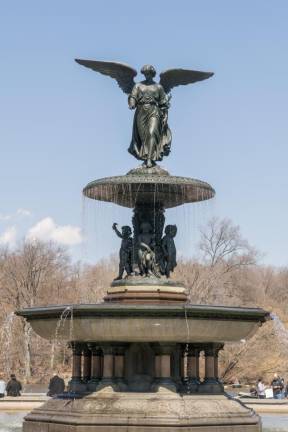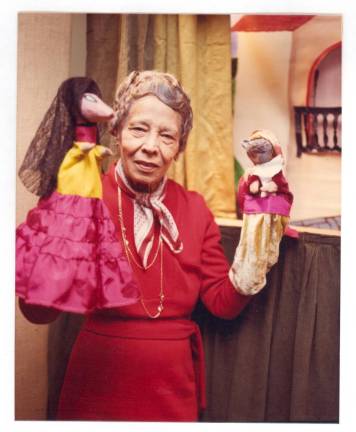'First' Ladies of Manhattan
In honor of Women’s History Month, Straus News salutes women whose paths to posterity passed through city neighborhoods. First two profiles in a series
Emma Stebbins: Creator of Central Park's "Angel"
“She's my favorite angel,” the character Prior tells the audience in the final scene of Tony Kushner’s Pulitzer Prize-winning play “Angels in America: A Gay Fantasia on National Themes.” “I like them best when they're statuary ... They are made of the heaviest things on earth, stone and iron, they weigh tons but they're winged, they are engines and instruments of flight.”
The statue the character so admires is “Angel of the Waters,” the centerpiece of the Bethesda Fountain at Central Park’s Bethesda Terrace. The 8-foot-tall bronze spirit overlooking the lake was sculpted by Emma Stebbins, the first woman artist to receive a commission from the city of New York.
The irony of rendering an angel’s ethereal beauty in heavy metal that Kushner highlighted on stage was just one of the contradictions Stebbins was tasked with reconciling as she created the piece.
For starters, there was Central Park architect Calvert Vaux’s grandiose vision, recorded in his 1863 report for the park commissioners, for a sculpture that would express "both earnestly and playfully the idea of that central spirit of 'Love' that is forever active, and forever bringing nature, science and art, summer and winter, youth and age, day and night, into harmonious accord."
When Stebbins set out to realize Vaux’s grand — though vague — objective, she was a 47-year-old, self-doubting “spinster” with only one public exhibition under her belt. Stebbins’s brother, Henry, a park commissioner, most likely landed her the Central Park job, while her life partner, actor Charlotte Cushman, aggressively promoted her work and negotiated her contracts.
Stebbins’s two great supporters hustled masterfully on her behalf, but they also found time to war against each other, as detailed in “The Public Career of Emma Stebbins: Work in Bronze” by Drexel University art history professor Elizabeth Milroy. Cushman sought to extricate Stebbins from her brother’s financial oversight, while Henry Stebbins railed against his sister’s lifestyle, as Cushman recounted in a letter, calling the women’s life together “morally, socially, and physically” damaging to Stebbins.
“Angel of the Waters” is based on a New Testament story, in which a magical healing fountain sprang up in Jerusalem where an angel had touched down on Earth.
The subject may have held a double meaning for the artist. The reservoirs located within the park had provided New Yorkers with running water, “which to all the countless homes of this great city, comes like an angel visitant,” as Stebbins wrote in the program for the fountain’s unveiling in 1873.
At the same time, in the 11 years between the commission and the unveiling, Cushman had been diagnosed with breast cancer. After surgery failed to cure her, a healing miracle may have seemed like her only hope.
The first reviews of “Angel of the Waters” were as contradictory as they come. The New York World reviewer gushed over "the grace, freedom and animation which are the distinguishing excellences of the work," while a New York Times critic deemed it “a feebly-pretty idealess thing of bronze.”
Shortly after completing the fountain, Stebbins put aside her art career to care for Cushman until she died in 1876. Stebbins then dedicated herself to publishing Cushman’s biography as her own health declined.
Years after Cushman’s death, Stebbins still referred to her in letters, invoking her name as one might a guardian angel. “I hope Charlotte will still hold her protecting shield over me — as she has always done,” Stebbins wrote in 1878, “and I shall escape, under cover of the love and tender interest which is so universally felt for her.”
Pura Belpré: NYPL's first Puerto Rican Librarian
Pura Belpré’s first children’s book, "Perez and Martina," told the folk tale of the romance between the beautiful cockroach Martina and Perez, the noble mouse who won her heart.
The evolution into becoming an author was a natural one for Belpré, who joined the New York Public Library as its first Puerto Rican librarian in 1921. Her hiring launched her decades-long career as an educator and activist promoting literacy in New York’s growing Latinx communities and broadening the library’s offerings to ensure that their cultures were represented.
Belpré was a college student when she came to New York for her sister’s wedding and decided to stay. Her arrival coincided with the start of a campaign by NYPL’s first ever children’s librarian, Annie Carroll Moore, to recruit staff from each of New York’s immigrant communities in order to foster a welcoming environment for all children.
As part of the certification program Moore developed for her new class of children’s librarians, Belpré had to demonstrate her skill as a storyteller. However, when she searched the library’s children’s stacks for books containing from Puerto Rico, she found nothing. So Belpré decided to wing it, telling the folk tales of her youth from memory.
Strangely, the library allowed her to tell stories without books on the condition that she tell the children present that the stories would be available in books soon, and in time, the line became true when her first book was published in 1932. "Perez and Martina" was originally published in English, with the Spanish version following later.
Archival footage from the period shows Belpré performing before a room of enraptured children dressed in their Sunday best who gaze up at her as they nurse their lollipops.
Belpré galvanized Latinx communities around the NYPL branches where she worked, first at 135th Street, then at West 115th Street and finally at the Aguilar branch on East 110th Street. Belpré was a master at engaging children, asking them to participate at story hours, as well as organizing events like raffles, card drives that drew them into the library, as well as events like Three Kings Day parties that carried on traditions from back in Puerto Rico.
“She was a magnificent educator,” lyric singer Eva de la O says at the opening of “Pura Belpré: Storyteller,” the 2012 documentary about her legacy produced by CENTRO, the Center for Puerto Rican Studies at Hunter College.
Today, CENTRO is home to Belpré’s archives, which include the 20 children’s books she authored in English and Spanish, the handcrafted puppets she performed with at story hour, and a vast collection of her writings.
“She’s kind of the patron saint of CENTRO,” Dr. Raquel M. Ortiz Rodriguez, the coordinator of CENTRO’s Puerto Rican Cultural Ambassadors program told Straus News. For the Cultural Ambassadors bootcamp, a crash course in Puerto Rican history and its impact, Ortiz begins by teaching the story of Belpré’s life as a parable for the impact of one person's commitment to representation.
Belpré’s legacy also lives on in the Pura Belpré Award for children's literature. The annual prize is awarded by the Association for Library Service to Children and REFORMA, an organization that advocates for Latinx-facing library services.
In an interview shortly before her death in 1982, Belpré called "Pérez y Martina" “my golden key,” a simple story that, as stories so often do, “has opened doors for me everywhere.”
When Emma Stebbins set out to realize Calvert Vaux’s grand — though vague — objective, she was a 47-year-old, self-doubting “spinster” with only one public exhibition under her belt.
Archival footage from the period shows Pura Belpré performing before a room of enraptured children dressed in their Sunday best who gaze up at her as they nurse their lollipops.


